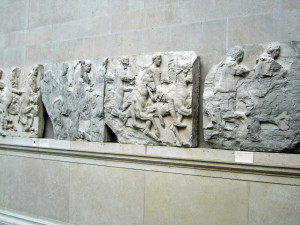Pericles built the Parthenon atop the Athens Acropolis in the fifth century B.C. to house a colossal statue of the goddess Athena. The colonnaded building, visible throughout the city, was the epitome of classic Greek architecture, adorned inside and out with exquisitely carved marble figures and friezes. As Athens later fell to different empires, the Parthenon was converted to a church and then a mosque and finally an ammunition dump. In 1687, gunpowder stored by the Ottomans exploded during a battle with the Venetians, severely damaging the Parthenon. The artwork was strewn amid the rubble.
In 1798, Thomas Bruce, the seventh Earl of Elgin, became British ambassador to the Sultan of the Ottoman Empire, then controlling Athens. Initially desiring only to make casts of the art he found in the Parthenon ruins, he later decided to take it home. Whether he wanted the pieces for his Scottish estate or to prevent further damage is still disputed. Whatever his motive, he obtained a controversial document from the Sultan purportedly giving him permission to remove “stones” from the Acropolis. Interpreting the document to permit the removal of anything made of stone, Lord Elgin personally spent 70,000 pounds to remove and ship to England about half of all the artwork of the Parthenon, including 17 pediment statues, 15 exterior panels called “metopes” depicting mythical battles, and 250 feet of the frieze honoring the Olympian gods that originally extended around the interior. Apparently needing money, he sold the items to the British government in 1816 for 35,000 pounds. Since the 1850s, the word “Elginism” has been used to describe cultural vandalism.
The Elgin Marbles are now displayed in British Museum’s Duveen Gallery, a large room built especially for them. The Greek government has repeatedly demanded their return as stolen art, a claim the British government has rejected. In 2014, UNESCO offered to mediate the dispute. Stay tuned.
